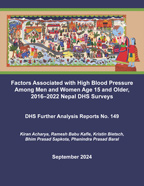There is no printed copy available to order.
Abstract:
Noncommunicable diseases (NCDs) are the leading cause of death in Nepal, projected to account for 79% of deaths by 2040. High blood pressure (HBP), a major risk factor for NCDs, affects one in five individuals. The increase in NCDs is also attributed to factors like tobacco use, poor diet, physical inactivity, and metabolic risks, yet efforts to mitigate their impacts in Nepal are progressing slowly, posing challenges in achieving Sustainable Development Goal Target 3.4 by 2030.
We used data from the 2016 and 2022 Nepal Demographic and Health Surveys, which were nationally representative surveys covering various demographic and health indicators. Using variables common to both surveys, we assessed factors associated with HBP among individuals age 15 and older, with particular attention to the treatment cascade for HBP (awareness, treatment, and control). Descriptive analyses, chi-square tests, and logistic regression were employed to analyze the data, adjusting for the surveys’ complex sampling design. The Svyset command in STATA version 17.0 was used to account for inverse probability weighting, clustering, and stratification, ensuring unbiased estimates of population parameters.
In 2022, HBP prevalence was higher among men (22.9%) than women (17.9%), with no significant changes observed from 2016 to 2022 across either sex. Provincial disparities were notable, particularly among women, with decreased odds of HBP in Madhesh, Karnali, and Sudurpaschim provinces compared with Koshi province. Age, education, wealth quintile, rural residence (men), nutritional status (women), and internet exposure were significantly associated with HBP. No significant associations were found between HBP and smoking habit, alcohol consumption, elevation, or indoor air pollution. Levels of awareness of HBP status were moderately high (>75%), with little change between surveys. However, treatment rates increased from less than 25% to more than 50%, leading to slight improvements in HBP control rates (which were less than 25% in both surveys).
Our findings highlight the complex interplay between sociodemographic and environmental factors in HBP management. Recommendations include targeting awareness campaigns for older individuals, considering provincial differences, and emphasizing women’s health.
 Factors Associated with High Blood Pressure Among Men and Women Age 15 and Older, 2016–2022 Nepal DHS Surveys (PDF, 2949K)
Factors Associated with High Blood Pressure Among Men and Women Age 15 and Older, 2016–2022 Nepal DHS Surveys (PDF, 2949K)
